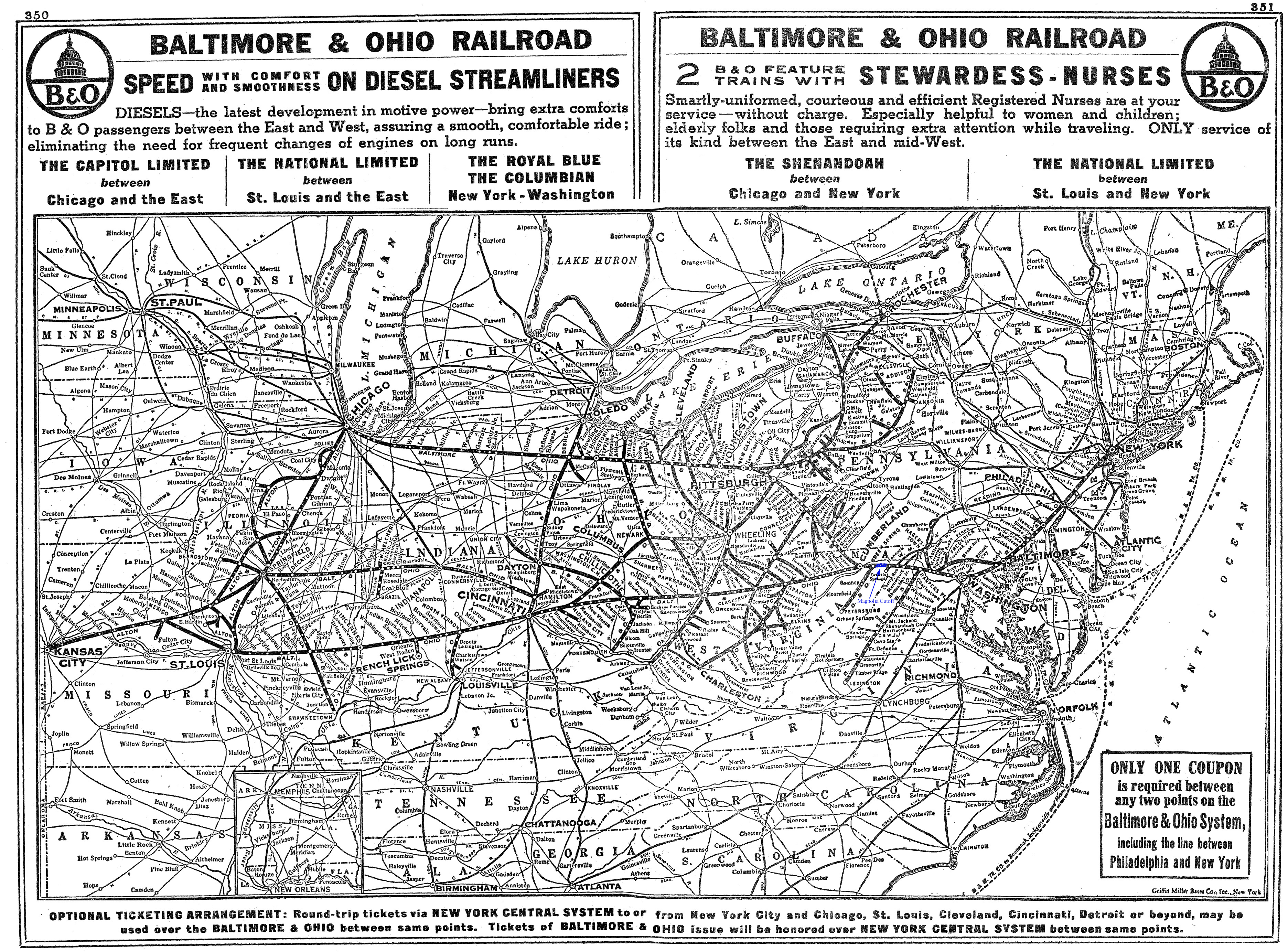B&O's Magnolia Cutoff
Last revised: October 11, 2023
By: Adam Burns
The Baltimore & Ohio's Magnolia Cutoff was a series of
tunnels, bridges, cuts, and fills constructed in the Eastern Panhandle
of West Virginia to alleviate grades, curves, and generally
straightening the company's main line east of Cumberland, which wound
along the Potomac River.
This new route, also known as the "Highline," greatly improved the railroad's main line through the region when constructed between 1913-1914. The B&O was always strapped for cash, particularly during the 20th century, but did its best to improve infrastructure when, and wherever possible.
Many of these, like Magnolia, were carried out under the railroad's most influential leader, Daniel Willard. He had an incredibly long tenure at the company (1910-1941), during which time he tried very hard to transform the B&O into a major competitor of the Pennsylvania and New York Central.
Willard even attemped to piece together a direct route to New York City via Pennsylvania during the 1930s but economic conditions of that time precluded his efforts.
Today, Magnolia remains an important artery under successor CSX Transportation. Interestingly, had the B&O boasted the financial means to carry out similar improvement projects - especially along its lines in West Virginia - it likely could have been much more competitive against its two larger rivals.
Photos
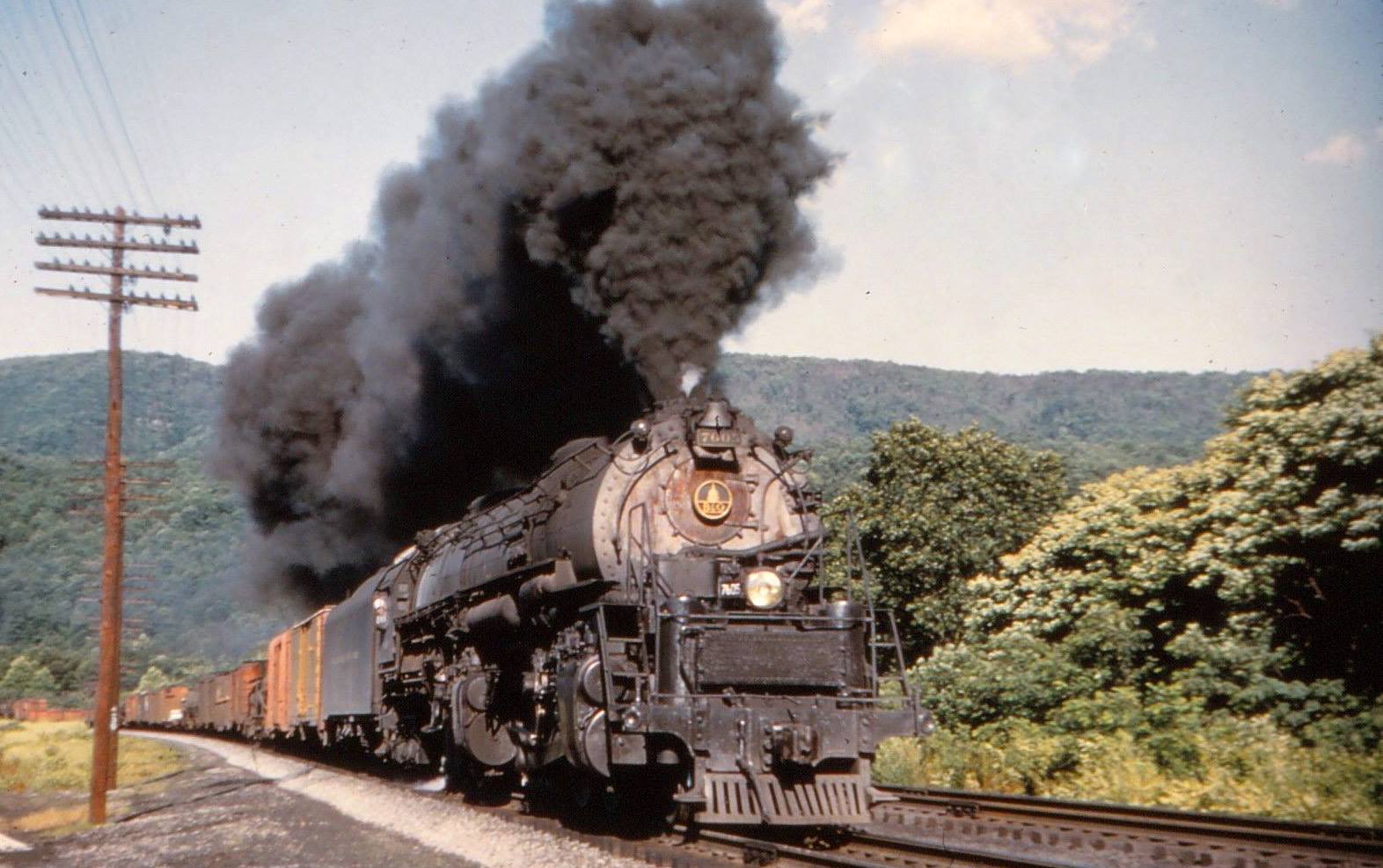 Baltimore & Ohio 2-8-8-4 #7605 (EM-1) works hard as it muscles a mixed freight over Magnolia Cutoff. Rust on the smoke box while the locomotive is still numbered in the 7600-series suggests this is an early 1950's scene. Photographer unknown.
Baltimore & Ohio 2-8-8-4 #7605 (EM-1) works hard as it muscles a mixed freight over Magnolia Cutoff. Rust on the smoke box while the locomotive is still numbered in the 7600-series suggests this is an early 1950's scene. Photographer unknown.History
The driving force behind the conception and implementation of the Magnolia Cutoff was Daniel Willard, who occupied the presidency of the B&O at that time. Willard wasted no time initiating the project as part of a larger effort to modernize and improve the efficiency of the B&O's network.
At the time the railroad had long dealt with a significant bottleneck on its system, Doe Gully Tunnel, located west of Martinsburg, West Virginia.
This single-tracked bore lay along the B&O's busiest corridor and caused numerous delays as trains traveling both east and west stacked up in each direction waiting their turn to pass.
The Magnolia Cutoff consisted of two substantial bridges, four tunnels, and several cuts and fills. The Doe Gully Tunnel was removed entirely and daylighted; the subsequent large cut was wide enough to house four tracks.
The cutoff was situated along the Potomac River in the Appalachian Mountains of West Virginia and Maryland. Its location was meticulously planned to provide the most efficient route possible for the B&O at this location.
The total cost was approximately $6 million, a significant expenditure for its time that was seen as an investment into the future of the railroad. It was also the last major improvement project carried out by the company.
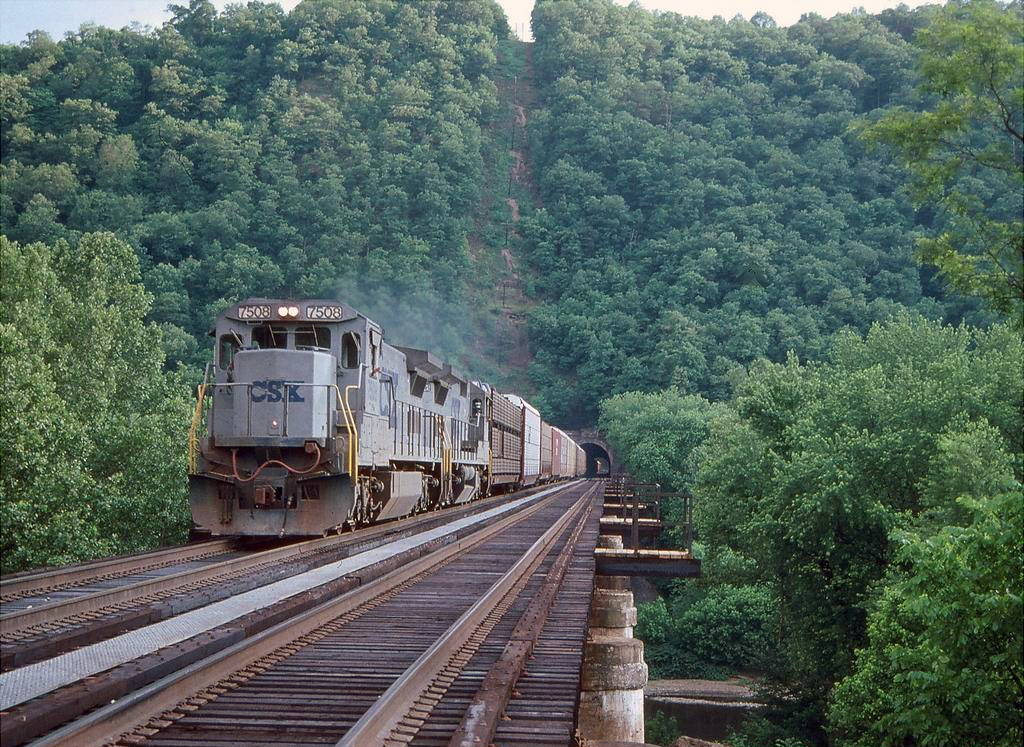 During the early CSX era two C40-8s sporting the early Stealth livery of sold blue and grey cross the Potomac River with a load of autoracks exiting 1,592-foot Graham Tunnel at Magnolia, West Virginia on June 1, 1991. Wade Massie photo.
During the early CSX era two C40-8s sporting the early Stealth livery of sold blue and grey cross the Potomac River with a load of autoracks exiting 1,592-foot Graham Tunnel at Magnolia, West Virginia on June 1, 1991. Wade Massie photo.Line Improvements
In the early 20th century the B&O began the task of straightening its main line through the hills and mountains of the Appalachians.
A few years before the Magnolia Cutoff project began the B&O had completed the Patterson Creek Cutoff several miles east near Cumberland, mostly to alleviate congestion and bypass the city's busy yards.
The B&O began the Magnolia project along the main line near Orleans Cross Roads, West Virginia at milepost 233.3, where the railroad would construct the Orleans Road Tower protecting the "Highline" and original "Lowline".
Intended to shave mileage and grades from the original route the project used tunnels and bridges to increase efficiency and bypass its original route the followed the winding Potomac River. The project also called for a double-tracked main line, which is still in place today.
Construction on the new line commenced on March 13, 1913 and had opened for service on December 6, 1914.
Once completed the cutoff shortened the distance between Orleans Road and Paw Paw by 5.8 miles, removed 887 degrees of curves, and practically eliminated grades.
Map (1940)
Tunnels
While the cutoff included two impressive bridges spanning the Potomac River on either side of Graham Tunnel its most impressive feature was the four tunnels. These bores were each named after one of the B&O's engineers.
They included Graham, Stuart, Randolph, and Keller Tunnels, and proved monumental feats of engineering and construction. The imposing Stuart Tunnel, stretching across a length of 3,555 feet, was the longest of the four.
(This information comes directly from the B&O's "Official List #29" dated January 1, 1948.)
Randolph Tunnel: Constructed in 1914 it is located 2.8 miles west of Orleans Road and carries 4 degrees of curve throughout its length. It is a total of 1,014.9-feet long, 24' 6" wide, and 31' high.
Stuart Tunnel: Constructed between 1913 and 1914 it is located 5.0 miles west of Orleans Road and carries 2.3 degrees of curve for a distance of 381.6 feet. It is a total of 3,355.4-feet long, 24' 6" wide, and 31' high.
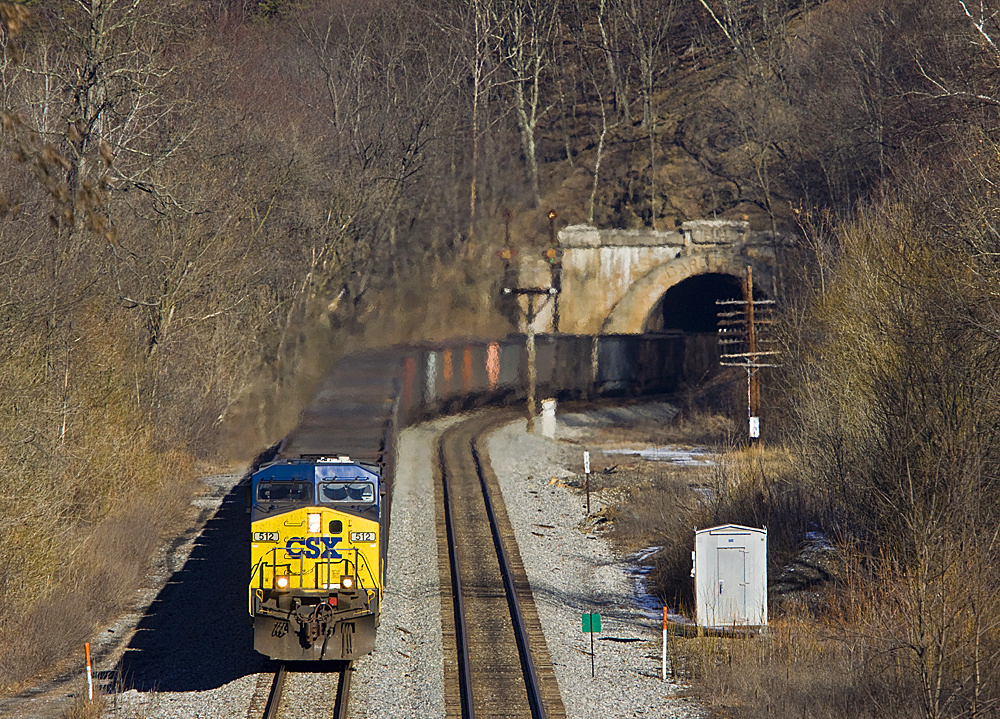 A CSX empty coal train (E819) led by a single AC4400CW, #512, exits Carothers Tunnel at Paw Paw, West Virginia on December 28, 2010. Wade Massie photo.
A CSX empty coal train (E819) led by a single AC4400CW, #512, exits Carothers Tunnel at Paw Paw, West Virginia on December 28, 2010. Wade Massie photo.Graham Tunnel: The only tunnel located in Maryland it was constructed between 1913 and 1914 and is located 4.1 miles east of Little Cacapon. It is a tangent (straight) 1,592 feet in length, 24' 6" wide, and 31' high.
Carothers Tunnel: Constructed between 1913 and 1914 it is located 3.2 miles east of Little Cacapon and carries 2.3 degrees of curve throughout its length. It is a total of 995.9-feet long, 24' 6" wide, and 31' high.
Moving westward the cutoff ended just east of Paw Paw, West Virginia at the Okonoko Tower, which protected the western convergence of the "Highline" and "Lowline" at milepost 252.2. Most of the new line was located in West Virginia but one small section did cross over into Maryland.
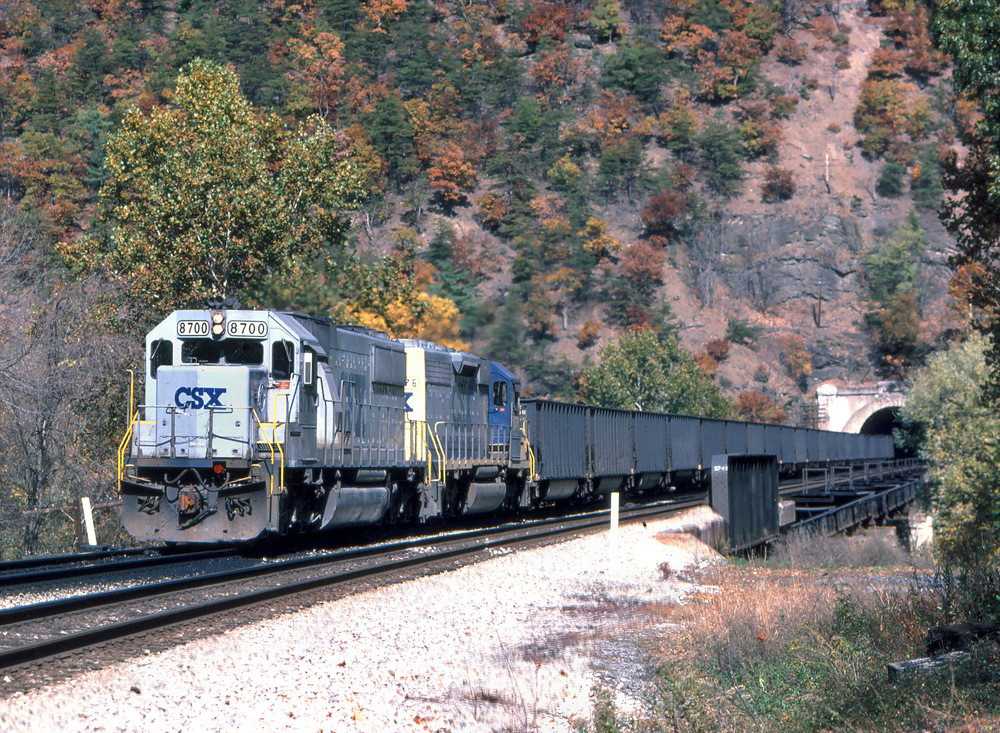 CSX train E110 carrying empty coal hoppers rolls westbound through Kessler, West Virginia along the Cutoff led by SD60 #8700 on October 24, 1993. Wade Massie photo.
CSX train E110 carrying empty coal hoppers rolls westbound through Kessler, West Virginia along the Cutoff led by SD60 #8700 on October 24, 1993. Wade Massie photo.While freight traffic used the much faster route along the cutoff passenger trains continued to use the original main line until 1961 when the B&O officially closed the circuitous line along the Potomac River.
Interestingly, the cutoff did include two additional connections prior to the B&O abandoning the original main line through the area: first, there was a connection to the "Lowline" at Doe Gully, West Virginia. Additionally, the railroad had a connection with the Western Maryland at milepost 239.7.
Legacy
Over a century after its creation, the Magnolia Cutoff remains an important component of modern rail transportation. Today, it is steadfastly operated by CSX Transportation, carrying on the legacy of the Baltimore & Ohio Railroad, and testament to the strategic genius of Daniel Willard.
The Magnolia Cutoff has an impressive array of engineering marvels along its length. The design of the project involved overcoming several geographical challenges through a combination of four tunnels and two bridges.
With the completion of the Magnolia Cutoff, the Baltimore & Ohio was able to significantly reduce its track distance by approximately 14 miles. This strategic curve elimination and grade reduction led to increased operational efficiency and cost savings, which helped the organization thrive.
Upon its completion, the Magnolia Cutoff helped cement the Baltimore & Ohio Railroad's standing as a leading railroad company. The project underscored the company's unrelenting focus on innovation and improvement, which allowed it to stay competitive in a rapidly changing industry landscape.
Under the stewardship of CSX Transportation, the Magnolia Cutoff is preserved as an essential part of America's rail network, and continues to serve its intended function, facilitating the smooth flow of commerce and people across the geography it links together.
CSX Transportation has made several upgrades since it took over the route in accordance to the advancements in technology. Signal systems, upgrades to electronic circuits, and radio systems are some of the few steps taken in the direction to modernize the old system.
Following the footsteps of its predecessor, CSX Transportation upholds the legacy of Daniel Willard and Baltimore & Ohio Railroad, as it continues to manage the Magnolia Cutoff, integrating it seamlessly into its 21,000-mile rail network that spans 23 states.
For those fascinated by rail history, the Magnolia Cutoff symbolizes a turning point in the evolution of American railroading. It is a testament to the ambition, innovation, and determination that characterized the early days of this vital industry.
From the onset of Daniel Willard’s vision to its execution, the Magnolia Cutoff has stood the test of time and even today, is considered a pivotal achievement within rail engineering. It serves as a constant reminder of America's industrial strength and innovative spirit.
The Magnolia Cutoff, characterized by its engineering genius and the daunting challenges it overcame, not only transformed the Baltimore and Ohio Railroad but set a precedent for subsequent railway projects around the world. The efficiency and ingenuity encapsulated in this project is, thus, a significant milestone in the history of rail transportation.
In conclusion, the Magnolia Cutoff is a masterstroke of engineering, reflective of the fortitude and vision of the Baltimore & Ohio Railroad under Daniel Willard's leadership. It continues to operate under CSX Transportation, signifying the indelible mark it has left on the world of rail transport, and standing as a poignant symbol of a bygone era of pioneering spirit and innovation.
Sources
- Mainey, David. Baltimore & Ohio Steam In Color. Scotch Plains: Morning Sun Books, 2001.
- Reynolds, Kirk and Oroszi, David. Baltimore & Ohio Railroad. Osceola: MBI Publishing, 2000.
- Schafer, Mike. Classic American Railroads. Osceola: MBI Publishing, 1996.
- Vrooman, David M. Daniel Willard and Progressive Management on the Baltimore & Ohio Railroad. Columbus: Ohio State University Press, 1991.
SteamLocomotive.com
Wes Barris's SteamLocomotive.com is simply the best web resource on the study of steam locomotives.
It is difficult to truly articulate just how much material can be found at this website.
It is quite staggering and a must visit!

